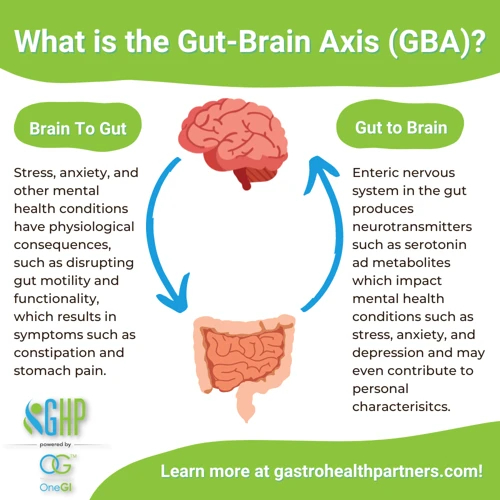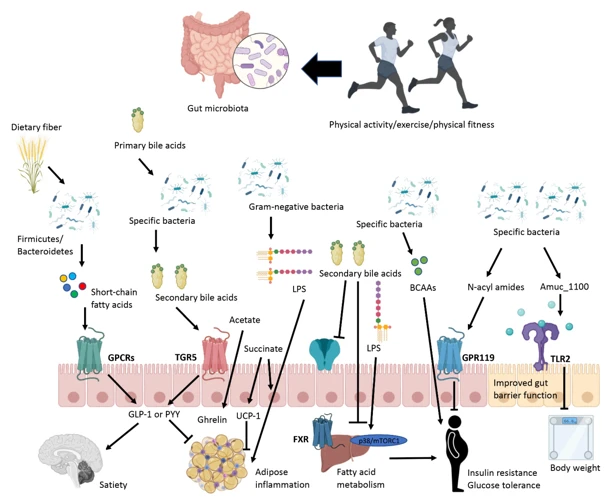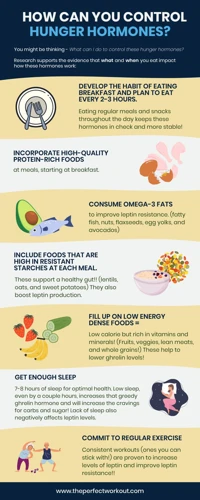The human body is a complex and intricate machine, and the more we learn about it, the more we realize just how interconnected all of its parts truly are. One example of this is the gut-brain connection, which refers to the relationship between our digestive system and our mental health. While this may seem like an unlikely pairing, research has shown that the health of our gut can have a major impact on our overall well-being. And, as it turns out, exercise is one of the most powerful tools we have for improving gut health and reducing cravings. In this article, we’ll explore the science behind the gut-brain connection, the benefits of exercise for gut health, and how you can make exercise a regular part of your routine to reap these benefits.
The Gut-Brain Connection

The human body is a complex and interconnected system, and nowhere is this more evident than in the relationship between the gut and the brain. The gut-brain connection is a fascinating and often perplexing area of study, as researchers continue to uncover new information about how these two systems communicate and influence each other. By exploring the biology of this connection, we can better understand the role that exercise plays in promoting gut health and reducing cravings. Let’s delve into the intricacies of the gut-brain connection and how it impacts our overall health and well-being.
Explaining the Gut-Brain Connection
The gut-brain connection is a complex and intricate communication system between the digestive system (gut) and the brain. It works through a network of neurons, hormones, and bacteria that send signals back and forth between the two.
Neurons are cells that transmit information throughout the body, including the brain and the gut. The gut has its own “brain,” called the enteric nervous system, which contains millions of neurons that work together to coordinate digestive activities like breaking down food and moving it through the digestive tract.
Hormones are chemical messengers that regulate various bodily functions including hunger, metabolism, and mood. The gut produces several hormones like ghrelin, which stimulates appetite, and leptin, which regulates energy balance, and the brain responds to these signals to adjust food intake.
Bacteria play a crucial role in maintaining gut health and influencing how the gut communicates with the brain. The gut is home to trillions of bacteria, collectively known as the gut microbiome, which help break down food, produce important nutrients, and support the immune system. Research suggests that the gut microbiome can also influence mood and behaviour.
The gut-brain connection is bidirectional, meaning that signals can travel in both directions. For example, the brain can influence gut activities like motility and secretions by sending signals via the sympathetic and parasympathetic nervous systems. Similarly, the gut can send signals to the brain via the vagus nerve, which connects the two systems.
Understanding the gut-brain connection is important because it has implications for overall health and well-being. Dysfunction in this communication system can lead to several health issues like gastrointestinal disorders, depression, anxiety, and even obesity. Fortunately, lifestyle changes such as exercise can positively impact the gut-brain connection and promote overall health.
How Exercise Impacts the Gut-Brain Connection
Regular exercise has been shown to have a profound impact on the gut-brain connection, which is the complex network of communication that exists between the brain and the gut. This connection is responsible for many important bodily functions, including regulating mood, appetite, and digestion. Here are several ways in which exercise can help improve the gut-brain connection:
- Reduced Stress: Exercise has been proven to reduce the levels of the stress hormone cortisol in the body. High levels of cortisol can contribute to inflammation in the gut, which can lead to a disruption of the gut-brain connection. Lowering cortisol levels can help to restore balance in the gut and improve communication between the gut and the brain.
- Increased Blood Flow: Exercise increases blood flow throughout the body, including to the digestive system. This increased blood flow can help to improve the health of the gut by delivering essential nutrients and oxygen to the cells in the gut.
- Improved Microbial Diversity: Exercise has been shown to increase the diversity of microbes in the gut. A diverse microbiome is key to maintaining a healthy gut-brain connection as it ensures a wide range of microbial functions, and the production of important neurotransmitters that influence mood and appetite.
- Regulated Appetite: Regular exercise can help to regulate appetite by improving insulin sensitivity. Improved insulin sensitivity leads to better blood sugar control, which can help to reduce cravings for unhealthy foods.
- Reduced Inflammation: Inflammation in the gut can impair communication between the gut and the brain. Exercise has been shown to have anti-inflammatory effects in the body, which can help to reduce inflammation in the gut and restore normal gut-brain communication.
By addressing each of these factors through exercise, individuals can promote the health of their gut-brain connection, which can lead to improved overall health and well-being.
The Benefits of Exercise on Gut Health

When it comes to promoting good overall health and well-being, exercise is key. Not only does it help strengthen our muscles and cardiovascular system, but it also has a positive impact on our gut health. Through a variety of mechanisms, exercise can help to reduce inflammation, improve digestion, and increase the diversity of microorganisms in our gut. In this section, we will explore in detail the many benefits of exercise on our gut health.
Inflammation Reduction
One of the benefits of exercise on gut health is the reduction of inflammation. Inflammation is a natural process in the body that helps to fight off infection and repair tissue damage. However, chronic inflammation can lead to a range of diseases and health issues.
When it comes to gut health, inflammation can contribute to conditions such as irritable bowel syndrome (IBS) and inflammatory bowel disease (IBD). Exercise has been shown to reduce inflammation in the gut and throughout the body, which can help to improve overall health and prevent these conditions.
Research has found that exercise can reduce the levels of inflammatory markers in the body, including C-reactive protein (CRP), interleukin-6 (IL-6), and tumor necrosis factor-alpha (TNF-alpha). A study published in the journal Brain, Behavior, and Immunity found that moderate exercise was associated with a decrease in TNF-alpha levels in overweight and obese adults.
In addition to reducing inflammation, exercise can also stimulate the release of anti-inflammatory compounds, such as interleukin-10 (IL-10). IL-10 is produced by immune cells and helps to regulate the immune response, which can help to prevent excessive inflammation in the body.
Incorporating regular exercise into your routine can have a significant impact on reducing inflammation and improving gut health. See the below table for a summary of the benefits of exercise on inflammation reduction.
| Benefit | Explanation |
|---|---|
| Reduces levels of inflammatory markers | Exercise has been shown to decrease levels of inflammatory markers such as CRP, IL-6, and TNF-alpha |
| Stimulates the release of anti-inflammatory compounds | Exercise can stimulate the production of compounds such as IL-10, which help to regulate the immune response and prevent excessive inflammation |
Improved Digestion
Regular exercise not only helps to improve overall health, but it can also have a significant impact on digestive health. By increasing blood flow and oxygen to the digestive system, exercise can stimulate the digestive process and reduce digestive issues. Here are some ways in which exercise can improve digestion:
- Reduces constipation: Exercise can help to reduce constipation by stimulating the muscles in the intestines, which move food through the digestive system. This can help to promote regular bowel movements and prevent constipation.
- Reduces bloating: Bloating can be caused by a number of different factors, including poor digestion and gas buildup in the intestines. Exercise can help to reduce bloating by promoting the movement of food and gas through the digestive system.
- Prevents acid reflux: Acid reflux occurs when stomach acid flows back into the esophagus, causing a burning sensation in the chest. Exercise can help to prevent acid reflux by improving digestion and reducing the likelihood of food and stomach acid backing up into the esophagus.
- Boosts nutrient absorption: Regular exercise can help to boost nutrient absorption by improving blood flow to the digestive system. This can help to ensure that the body is able to absorb all of the nutrients from the food that it consumes.
It’s important to note that while exercise can have a positive impact on digestive health, it’s also important to maintain a healthy diet and stay hydrated to optimize digestion. Additionally, individuals with gastrointestinal issues should consult with a healthcare professional before starting a new exercise routine.
Increased Microbial Diversity
The gut microbiome is inhabited by trillions of microorganisms, and scientists are still discovering new ways in which these bacteria affect our overall health. One of the key benefits of exercise on gut health is that it can lead to an increase in microbial diversity, a crucial component of a healthy gut.
Studies have shown that individuals who maintain a regular exercise routine have a more diverse gut microbiome compared to those who are sedentary. This is important because a greater diversity of microorganisms can improve digestion, boost immunity, and even regulate mood.
Exercise increases microbial diversity by creating an environment in the gut that is rich in oxygen and nutrients. As we exercise, our body produces a variety of compounds that can positively affect the gut microbiome. For example, short-chain fatty acids (SCFAs) are produced during exercise and are known to promote the growth of beneficial bacteria, such as Bifidobacteria and Lactobacilli.
Additionally, exercise can improve gut motility, or the rate at which food moves through the digestive tract. This can prevent harmful bacteria from overpopulating the gut and causing inflammation.
An increase in microbial diversity caused by exercise can have numerous benefits for our health. Incorporating regular exercise into our routine can create a more hospitable environment for the gut microbiome, leading to improved digestion, immunity, and mood.
Reducing Cravings with Exercise

For many people, cravings can feel like an inevitable part of life. Whether it’s a sudden desire for sweets, salty snacks, or fast food, these intense urges can be difficult to resist. However, recent research has shown that exercise can play a key role in reducing cravings and promoting healthier eating habits. By understanding the science behind cravings and how exercise can affect our brain chemistry, it’s possible to develop strategies that support better overall health and well-being. Let’s explore the fascinating connection between exercise and our craving response.
The Science of Cravings
It’s no secret that existing cravings can make it tough to stick to a healthy diet. But what exactly causes these cravings? The answer lies in the human brain and its relationship with food. Here are several scientific factors to consider:
- Dopamine response: Dopamine is a brain chemical that plays a major role in reward-motivated behavior, and it is triggered by food that is high in sugar, fat, and salt. When people eat these types of food, the brain releases dopamine, which causes the individual to feel good and reinforces the behavior.
- Stress response: Stress affects the brain’s reward system by activating the hypothalamus-pituitary-adrenal (HPA) axis, which leads to cortisol release. Cortisol is a stress hormone that triggers the release of glucose, among other things, in preparation for the fight-or-flight response. Unfortunately, cortisol can also make people crave high-calorie, high-carbohydrate foods, which can lead to weight gain.
- Habit loops: Habits are formed by a predictable loop of cue, routine, and reward. In the case of food, the cue can be anything from a particular time of day to a specific emotion. The routine is the action of eating, and the reward is the feeling of satisfaction that follows. Over time, this loop becomes increasingly automatic and ingrained, making it difficult to change unhealthy eating habits.
- Imbalance of hormones: Hormonal imbalances can also trigger cravings. For example, low levels of serotonin, a neurotransmitter that regulates mood, can lead to carbohydrate cravings.
As you can see, cravings can be incredibly challenging to overcome. However, incorporating exercise into your routine can help reduce cravings and make it easier to stick to a healthy diet.
How Exercise Reduces Cravings
Exercise is a powerful tool for reducing cravings as it affects multiple aspects of our physiology. One of the main ways exercise reduces cravings is by releasing endorphins, which are feel-good chemicals that help reduce stress and anxiety. These chemicals are also responsible for the “runner’s high” that many people experience after a workout.
Another way exercise reduces cravings is by regulating blood sugar levels. When we eat foods high in sugar or simple carbohydrates, our blood sugar levels spike, causing a surge of insulin to be released. This insulin surge can lead to a rapid drop in blood sugar levels, which can trigger cravings for more sugar or carbohydrates to restore energy levels. However, regular exercise helps to regulate blood sugar levels by improving insulin sensitivity and reducing insulin resistance, helping prevent these drops in blood sugar levels that lead to cravings.
Regular exercise also helps to increase levels of the hormone leptin, which is responsible for regulating appetite and satiety. When we exercise, our muscles release a protein called irisin, which boosts the production of leptin, leading to a decrease in appetite and calorie intake. This decrease in appetite can help reduce the frequency and intensity of cravings for high-calorie foods.
Lastly, exercise can also help to distract us from our cravings by providing a healthy and enjoyable activity to engage in. By focusing our attention on our exercise routine, we are less likely to focus on our cravings for unhealthy foods, leading to a reduction in those cravings overall.
Exercise is a powerful tool for reducing cravings, both in the short-term and long-term. By releasing endorphins, regulating blood sugar levels, increasing leptin levels, and providing a healthy distraction, regular exercise can help reduce the frequency and intensity of cravings for unhealthy foods.
| Ways Exercise Reduces Cravings |
|---|
| Releases endorphins |
| Regulates blood sugar levels |
| Increases leptin levels |
| Provides a healthy distraction |
Tips for Incorporating Exercise Into Your Routine
Finding the motivation to incorporate exercise into your daily routine can be challenging, but the benefits to both your physical and mental health are undeniable. Whether you’re just starting out or looking to switch up your current routine, these tips can help you make exercise a consistent part of your lifestyle. From taking it slow to finding activities you truly enjoy, incorporating exercise into your routine doesn’t have to be a daunting task.
Start Slowly
When it comes to incorporating exercise into your routine to improve your gut health and reduce cravings, it’s important to start slowly, especially if you’re new to working out or haven’t exercised in a while.
Here are some tips for starting slowly:
- Consult with a healthcare professional: Before starting any exercise program, it’s important to consult with your healthcare professional, especially if you have any pre-existing medical conditions or injuries. They can help you determine what types of exercises are safe for you to do and provide recommendations on how to get started.
- Set realistic goals: Start by setting small, realistic goals for yourself. For example, if you haven’t been exercising at all, aim to go for a 10-minute walk once a day for a week. Once you’ve achieved that, you can gradually increase the duration and intensity of your workouts.
- Listen to your body: It’s important to listen to your body and not push yourself too hard. If you feel pain or discomfort during exercise, stop immediately and rest. It’s normal to feel some soreness after a workout, but if you’re experiencing severe pain, it’s a sign that you need to slow down.
- Switch it up: Trying out different types of exercises can help prevent boredom and keep things interesting. You might enjoy going for a jog one day, doing yoga the next, and going for a bike ride on the weekend.
- Track your progress: Keeping track of your progress can help you see how far you’ve come and stay motivated. You might choose to track how long you can walk for, how many squats you can do, or how fast you can run a mile.
Starting slowly and gradually increasing the intensity and duration of your workouts is important when it comes to improving your gut health and reducing cravings through exercise. By setting realistic goals, listening to your body, trying out different exercises, and tracking your progress, you can make exercise a regular part of your routine and reap the rewards for your physical and mental health.
Find What You Love
When it comes to exercise, finding what you love is key to making it a sustainable habit. There are many different types of exercise out there, and no one-size-fits-all solution. Here are some tips for discovering what types of exercise might be best for you:
- Try new things: Don’t be afraid to try different types of exercise until you find something you enjoy. Consider taking a dance class, trying a yoga session, or hopping on a bike. You never know what you might love until you give it a shot.
- Think about what motivates you: Are you motivated by competition? Consider joining a sports team. Do you enjoy being outdoors? Going for a hike or run could be the answer. Understanding what motivates you can help you find the right type of exercise for you.
- Make it social: If you are someone who enjoys being around others, consider joining a group fitness class or a running club. Making exercise social can help keep you accountable and make it more enjoyable.
- Listen to your body: Above all, make sure you are enjoying your workouts and listening to your body. If you are forcing yourself to do something you don’t enjoy or that makes you feel uncomfortable, it will be difficult to maintain that routine in the long run.
Remember, finding what you love is a process and may take some trial and error. But by exploring different types of exercise, thinking about your motivations, making it social, and listening to your body, you will be able to find a sustainable routine that works for you.
Make Time for Exercise
One of the biggest challenges many people face when it comes to exercise is finding the time to actually do it. However, making time for exercise is essential if you want to improve your gut health and reduce cravings. Here are some tips for finding the time to exercise:
- Map Out Your Schedule: Take a look at your typical weekly schedule and identify pockets of time where you could realistically fit in some exercise. Maybe you can wake up 30 minutes earlier in the morning to squeeze in a quick workout before starting your day. Or maybe you can carve out time during your lunch break to take a brisk walk.
- Create a Routine: Once you’ve identified some possible time slots for exercise, stick to them as much as possible. Creating a routine around exercise can help make it feel more like a non-negotiable part of your day. Consider scheduling your workouts in your calendar or setting reminders on your phone to help keep you accountable.
- Find Ways to Multitask: If you’re struggling to find dedicated time for exercise, consider finding ways to multitask. For example, you could listen to a podcast or audiobook while taking a walk or jog. Or you could do a quick stretching routine while watching TV in the evening.
- Be Realistic: It’s important to set realistic expectations for yourself when it comes to exercise. If you’re new to working out, don’t expect to jump right into a rigorous daily routine. Instead, start small and gradually build up your workouts over time. This will help you avoid feeling overwhelmed and give you a better chance of sticking with exercise long-term.
Remember, making time for exercise is an investment in your overall health and well-being. By prioritizing exercise, you’ll not only improve your gut health and reduce cravings, but you’ll also feel more energized, less stressed, and better equipped to handle the challenges of daily life.
Conclusion
In conclusion, exercise not only helps to improve our physical health, but it can also have a significant impact on our gut health and reduce cravings. Through the gut-brain connection, exercise can positively affect our microbiome, reducing inflammation, improving digestion, and increasing microbial diversity. Additionally, exercise has been shown to reduce cravings by increasing dopamine levels and altering our perception of food.
If you want to incorporate exercise into your routine, it’s important to start slowly and find what type of exercise you enjoy. Making time for exercise can be challenging, but setting a realistic schedule and prioritizing physical activity can have numerous benefits for both your mental and physical health.
Incorporating exercise into your daily routine can be a powerful tool in improving your gut health and reducing cravings. By prioritizing physical activity and making positive lifestyle changes, you can support a healthier, happier you.
Frequently Asked Questions
Can exercising really improve gut health?
Yes, exercise can improve gut health by reducing inflammation, improving digestion, and increasing microbial diversity in the gut.
How does exercise impact the gut-brain connection?
Exercise can improve the gut-brain connection by increasing the production of beneficial neurotransmitters such as serotonin and dopamine, which can improve mood and reduce stress levels.
What are the benefits of exercise on gut health?
The benefits of exercise on gut health include reducing inflammation, improving digestion, and increasing microbial diversity in the gut.
What is inflammation and how does it relate to gut health?
Inflammation is the body’s response to injury or infection. Chronic inflammation in the gut can lead to various health issues such as Crohn’s disease, ulcerative colitis, and irritable bowel syndrome (IBS).
How can exercise help reduce cravings?
Exercise can reduce cravings by increasing the production of hormones such as endorphins and dopamine, which can regulate appetite and reduce the desire for unhealthy foods.
What are some tips for incorporating exercise into a daily routine?
Starting slowly, finding what you enjoy, and making time for exercise are all great tips for incorporating exercise into a daily routine.
What is the gut-brain axis?
The gut-brain axis is the complex system of communication between the gut and the brain. It involves both the nervous system and the endocrine system.
What is microbial diversity and why is it important for gut health?
Microbial diversity refers to the variety of microorganisms that live in the gut. A diverse gut microbiome is important for digestion, immune function, metabolism, and overall health.
How can exercise improve digestion?
Exercise can improve digestion by increasing blood flow to the gut, promoting gut motility, and reducing the risk of constipation.
What are some common cravings and how can exercise help reduce them?
Common cravings include sugar, salt, and unhealthy fats. Exercise can help reduce these cravings by regulating appetite hormones and increasing feelings of fullness.







